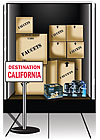
This month marks the two-year countdown until the Great State of California enacts its lead in plumbing legislation. To many, including myself, this is bad legislation enacted by uninformed legislators.
California decided to require all plumbing products in contact with drinking water to have a maximum lead concentration of 0.25 percent. That becomes their legislators’ definition of lead-free. This is legislation that we refer to as WAG legislation - WAG meaning “wild ass guess.”
There is no rhyme or reason for having lead levels in plumbing products at 0.25 percent. That does not translate into any specific amount of lead that may be in your drinking water.
For almost 20 years, we have used the test protocol of NSF 61 to establish acceptable materials for use in plumbing systems. The test protocol in the standard actually determines the maximum amounts of lead that will leach into the drinking water under the most severe conditions. In most water systems, such a severe condition does not exist.
Many consider NSF 61 to be too tough a standard because it measures lead and other contaminants using water that is very aggressive. However, that is acceptable, since for most systems, the level of contaminants will be almost nonexistent.
Get The Lead Out
When you ask experts in the area of lead how much is an acceptable level, the answer will be zero. From all of the research, we know that there is no acceptable level of lead that a human should consume - all lead is bad; no lead in your body is good. Hence, the goal of everyone in the plumbing industry is to have no lead in the drinking water.That doesn’t mean we have to stop using lead in brass and bronze. What it means is that we have to prevent lead from leaching into the drinking water.
There are many different approaches used by manufacturers to get the lead-leaching level close to zero. The problem with the California legislation is that it has no bearing on the amount of lead that will leach into the drinking water. A concentration of 0.25 percent means nothing.
As an afterthought, California made reference to NSF 61. While it’s about time, if the legislators had any common sense at all, this is all that they would reference.
Another problem with this bad legislation is that the plumbing faucet manufacturers ended up agreeing with the California legislation. Rather than fighting it, they decided to acquiesce with the legislation in the hopes of finding the necessary loopholes to comply.
It was a tough call for the faucet manufacturers, since it is expensive to fight legislation, as bad as it might be. They also were being portrayed as the evil corporations that don’t care about the health of the citizens of California.
Of course, that couldn’t be further from the truth. The faucet manufacturers have driven the code requirements to lower lead levels in drinking water. They have spent millions improving the quality of their products.
Groups from California decided to turn to NSF to get a definition of products having lead concentrations of 0.25 percent or less. This is where the manufacturers hoped to have their loophole defined. They have proposed to evaluate all of the wetted surfaces in a faucet and evaluate those surfaces for total concentration of lead.
It is smart move on their part to use this overall concept of evaluating a product. In a faucet, there are many surfaces that are not brass or bronze, hence, no lead in the formulation. O-rings, washers and many seats do not have lead. If plastic components are used in the waterway, there is no lead in those components, as well. The end result is that the brass or bronze may have more than 0.25 percent lead, but the overall faucet will not.
What Are The Options?
I happen to serve on the committee reviewing this information. While I can see the need for faucet manufacturers to make the best of this bad legislation, it will not get rid of the attorneys that want to interpret the law in a different manner evaluating brass components individually, not as an entire faucet.The other problem is that by adding this text to NSF 61, it could be considered as downgrading a very well-respected standard. Political nonsense would be added to a respectable health effect standard.
Finally, while this proposal would help the faucet manufacturers, it would not do much good for brass and bronze valve manufacturers, nor cast fittings in copper systems. A ball valve could have a stainless-steel ball that might help to bring down the levels, but what about globe valves?
An option for cast-copper fittings would be to line the fittings so that the wetted surfaces are not brass or bronze but coated. The problem with coating the fittings is that coating will most likely burn off if you solder the fittings. Hence, the fittings will have to be joined in another way than soldering.
There also are brass fittings used in PEX systems, brass and bronze manifolds, and threaded brass fittings in CPVC. All of these fittings would not be able to use the faucet manufacturers’ loophole.
The faucet manufacturers claim they don’t want to make two lines of products -one for California and one for the rest of the country. However, automobile manufacturers have been doing just that for years. Furthermore, it appears that the valve and fitting manufacturers will not have much of a choice. Plus, I don’t want to pay a higher price for my plumbing products just because California passes goofy legislation.
For those of you in other states, make sure you educate your state legislators to not copy this bad legislation from California. Just have them reference the latest edition of NSF 61. This is what will reduce the lead level in drinking water.
